Friday essay: make some noise — the (forbidden) joy of crowds
- Written by Sally Breen, Senior Lecturer in Writing and Publishing, Griffith University
I live in what was one of the noisiest city precincts, pre-pandemic, in the country — Surfers Paradise — golden lit, white noise jewel of the Gold Coast.
The pandemonium vibe both natural and man-made, big waves crashing right up to the edges of the cityscape competing with the clangour of human joy and the human stain. My front yard — the azure Pacific and my backyard, Orchid Avenue, home to shiny super clubs, old bolt holes rebranded or new kids on the block, clubs that never even got to open, neon signs glittering more than their insides, the newest — Asylum — flashing on and off in a peculiar reminder of where we have ended up.
Usually Surfers is pumping. There are sirens all the time, a thousand scooters and every form of stupid kart, hired out to families from down south who take over the joint like there is no bedtime in paradise.
Horns, kids in pools, Lamborghinis and Skylines doing laps, gangs of skateboarders cruising the Esplanade, the wide concrete swathes host to their tricks and a kilometre-long market running every second evening, the unofficial motorbike convention rolling in on Saturday nights to chew the fat, hen’s nights in Hummers. 20,000 visitors a day. Middle Eastern families, kids from Logan, Chinese entourages, posses of French, Spanish and Argentinian gods and goddesses. Silence here isn’t normal. That’s why when the pandemic hit, it was next level eerie.
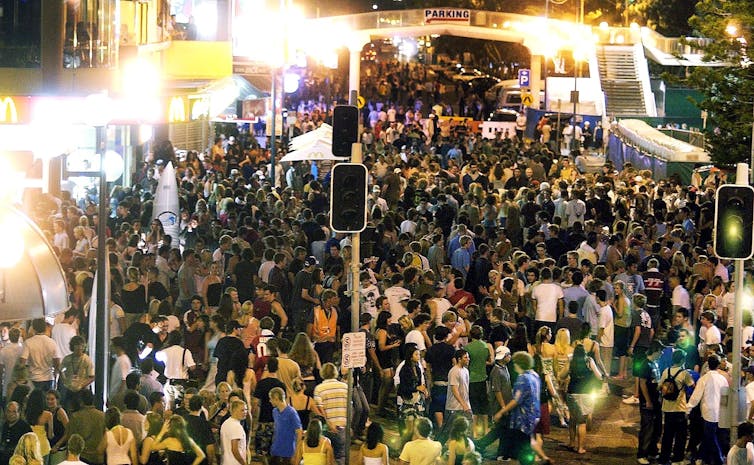 A crowd of schoolies from another epoch.
Tony Phillips/AAP
A crowd of schoolies from another epoch.
Tony Phillips/AAP
On the first of May I took a stroll through the streets, even though I probably wasn’t supposed to. Well past the Cinderella hour, I saw not a single soul. Not even the kebab shops and the convenience stores placed at handy ten meter intervals were alight, no bored strippers leaning up against fake marble pillars, not one car moving, only cop cars, lined up in a shiny, stagnant row outside the police station.
Some might venture this was an improvement, but for a renegade like me who doesn’t mind the volume dialled up to 50, the scene was more post-apocalyptic than any previous version of Surfers. It was, in a word — boring. I say this in full acknowledgement of the seriousness of what’s become the global Corona horror show. The lives lost and the lives yet to go down the economic fallout drain.
But those memes circulating about us all heading into the apocalypse in our bathrobes and lounge-wear captured something of the inertia and restlessness we were feeling. A void of interaction has you questioning the meaning — of everything. For what are we left with without each other, without the crowd? Without the teeming masses that sometimes drive us crazy or even to despair? It is a world without the sounds we make. The good, the bad and the ugly.
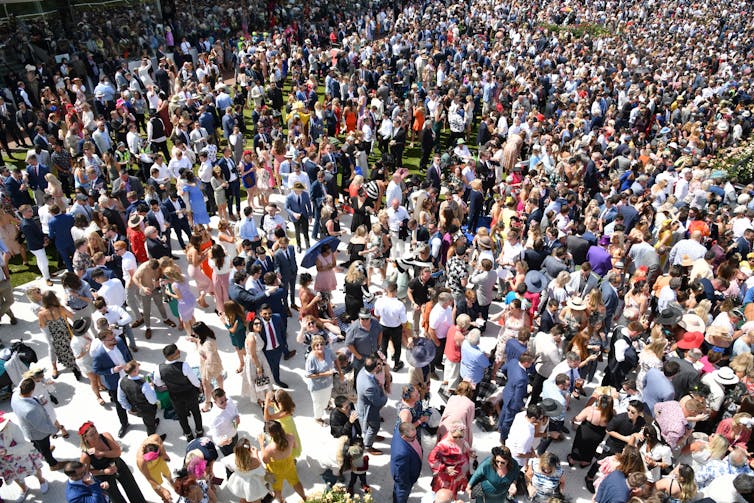 The teeming masses … last year’s Melbourne Cup.
Vince Caligiuri/AAP
The teeming masses … last year’s Melbourne Cup.
Vince Caligiuri/AAP
Solitude as a choice
At first, I kinda liked the holes COVID-19 had buried me into. I’ll dance on a table until 3am but then I’ll want to disappear and think about it for, well, at least seven days. Most writers are like this. On the spectrum between hedonists and hermits. (The modernists more firmly in the latter pack — but I guess you can empathise with a mistrust of crowds in the 20th century.) The herd, the groupthink, rubs right up against the grain. A sentiment exemplified by Carl Jung when he said,
A group experience takes place on a lower level of consciousness than the experience of an individual. This is due to the fact that, when many people gather together to share one common emotion, the total psyche emerging from the group is below the level of the individual psyche. If it is a very large group, the collective psyche will be more like the psyche of an animal.
Jung might have been onto something but perhaps his take is only part of the story. Crowds can be lowest common denominator and maddening, but when the pandemic hit, I realised solitude is only preferable when it’s a choice.
Musos and sports stars generally love crowds — they know how important they are, hometown advantage, ticket sales, energy. When the AFL opened up to crowds again in July, the Twittersphere erupted in gratitude. People had “tears in their eyes” and the roar was “awesome”, “beautiful”. “I vow to never take genuine crowd noise like this for granted ever again,” said one fan.
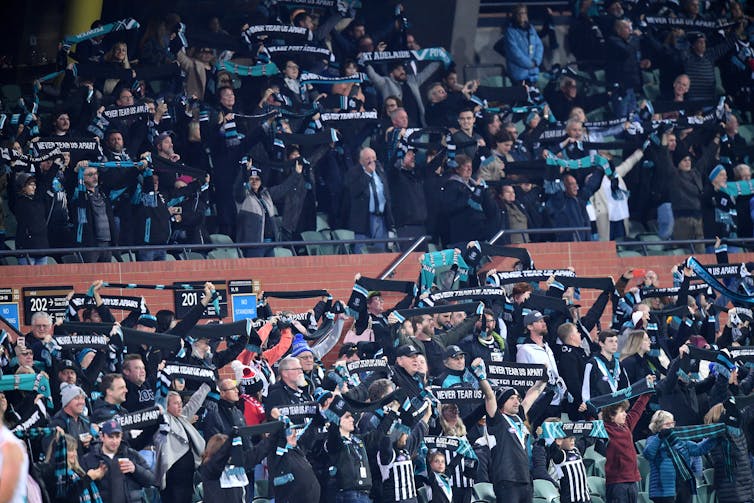 A footy crowd returns to Adelaide on July 25 this year.
David Mariuz/AAP
A footy crowd returns to Adelaide on July 25 this year.
David Mariuz/AAP
We didn’t want cardboard faces in the seats, cameramen trying to avoid the sweep of empty grandstands. We wanted “proper crowds” not fake ones, where our joy and rage got dubbed in for our consumption.
 We didn’t want cardboard faces in the seats.
Dean Lewins/AAP
We didn’t want cardboard faces in the seats.
Dean Lewins/AAP
Just like ‘boom!’
I was supped on crowds as a kid, and the best, most terrifying, glorious mass to be in was a sellout Queensland State of Origin crowd at Lang Park, when the beer was full strength, before they banned glass. A hallowed ground nicknamed the Cauldron, because its original intimate configuration resembled a pot, a hive where the intensity of the crowd could strike fear into the hearts of the opposition.
Read more: Footy crowds: what the AFL and NRL need to turn sport into show business
Lang Park was paganistic, with the steam rising and the baying for blood, always on the verge of violence but not quite tipping over because the passion wasn’t just about sport, the passion was political. Queenslanders making a point.
Early era Brisbane Broncos and Maroons player Paul Bowman summed it up. “We’re battlers, we’ve always got to scrap for what’s ours and what we deserve. I think there’s a lot of Queenslanders with that attitude. Southerners […] probably think about us as second-class citizens.”
He went on to describe the crowd at Lang Park as “unbelievable”. And almost every other player who ran out onto that paddock in a Maroon jersey has had something to say about it too.
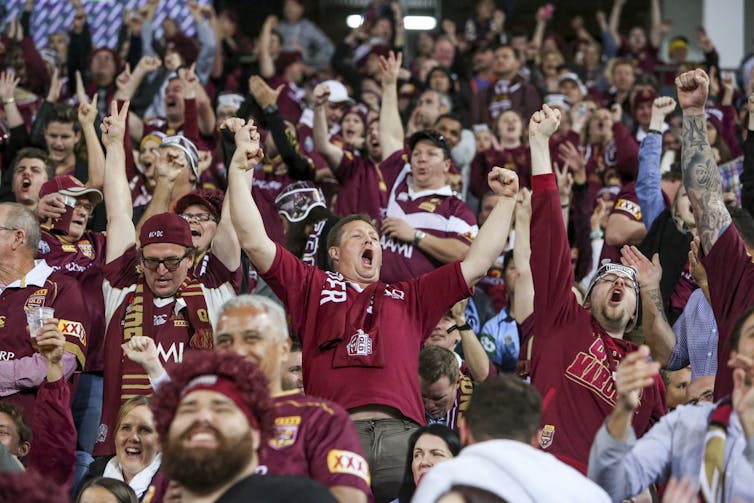 Maroons fans cheer during a State of Origin Game in 2017.
Glen Hunt/AAP
Maroons fans cheer during a State of Origin Game in 2017.
Glen Hunt/AAP
Former Origin star Gavin Allen: “The crowd was louder than any crowd I have played in front of. This crowd was just out of control.”
And Steve Renouf, known as one of NRL’s greatest centres and a Queensland Origin legend. “You walk out there, and they said it just really hits you and it does, the crowd is just like ‘boom’!”
Ephemeral power
You never forget those moments when you become part of something bigger than you, something stronger, louder and fiercer, something outside of your control. A crowd can exhilarate the ephemeral power in us.
French polymath Gustave Le Bon captures some of this unnameable force when he says,
Crowds display a singularly inferior mentality; yet there are other acts in which they appear to be guided by those mysterious forces which the ancients denominated destiny, nature, or providence, which we call the voices of the dead, and whose power it is impossible to overlook, although we ignore their essence. It would seem, at times, as if there were latent forces in the inner being of nations which serve to guide them.
When I got older that desire for a collective merging shifted — same stadiums, different offerings on the menu — mosh pits of thousands slivering and snaking to the Prodigy or Beastie Boys or Ministry, hive mind of their own, where the point was to fling yourself into other bodies and be carried away by them, where a multitude became one, sweat and spit flying and sometimes blood, in unbridled proximity.
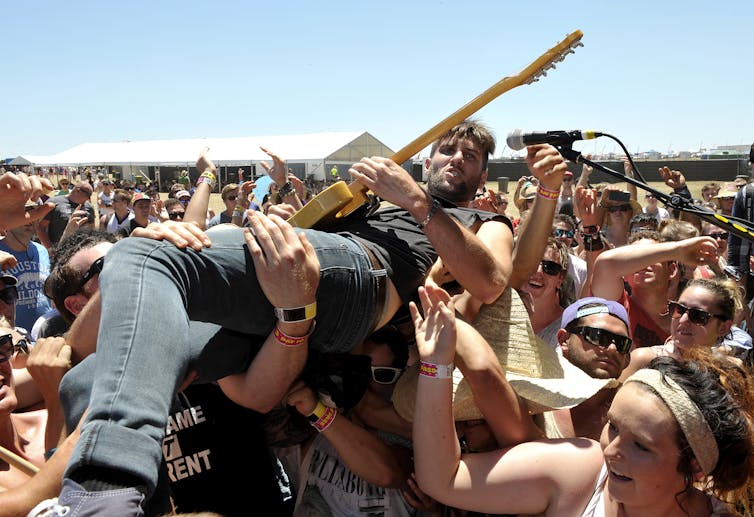 The point of the mosh pit was to fling yourself into other bodies and be carried away by them.
Martin Philbey/AAP
The point of the mosh pit was to fling yourself into other bodies and be carried away by them.
Martin Philbey/AAP
Of course, distrust of the crowd has always been elitist. Crowds change things: temperatures, moods, security levels. And they end things: reigns, wars, ideological creep. Conversely, they can also signify these things or generate them, hence our uncomfortable relationship with validating a war cry.
One thing’s for sure, right now, a crowd anywhere in any form is asking for trouble — but in essence that’s what crowds are for.
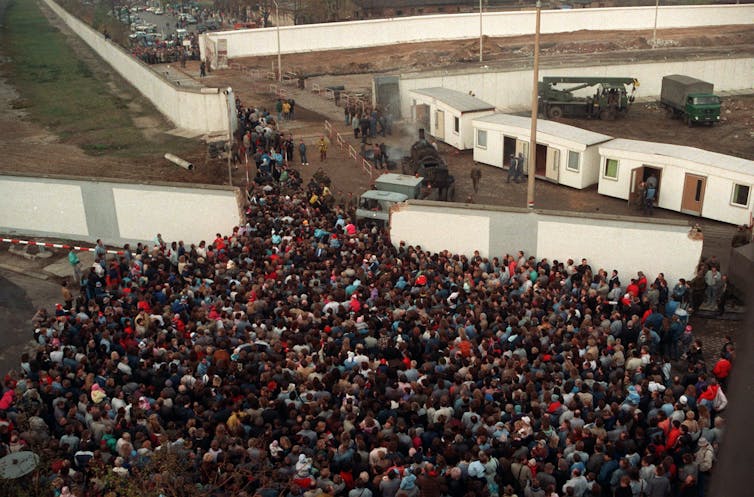 East Berlin residents waiting to cross into West Berlin after the fall of the Berlin Wall in Germany in November 1989.
EPA
East Berlin residents waiting to cross into West Berlin after the fall of the Berlin Wall in Germany in November 1989.
EPA
The film Italy’s War on Covid documents the day-to-day struggles of Dr Francesca Mangiatordi, ER Director of the Cremona Hospital in the north of Italy, one of the hardest hit regions in the world.
We bear witness to the unbearable choices she had to make between ventilating the young or the old, the hand of her co-worker’s son pressed up against the pale yellow glass on a door his mother is isolating behind. Nurses stripping off their anti-viral gear staring at their over-tired faces in the mirror. Mangiatordi’s young son in very enthusiastic Italian, comparing her to Captain America. She is a warrior and at the end of the doco, when her unit has regained some semblance of normality she says
I believe the moment we can say there is no risk of contagion, everyone will let out a thunderous roar.
She would know.
A roar of relief
It’s Saturday night on the May Day long weekend and my partner and I are bored. Usually a long weekend signals the need for veranda gatherings and the city gets hit with all kinds of trippers. But the city is quiet, no parties in the towers, no cars on the roads and the most exciting thing you’re allowed to do is walk down the street to pick up your takeout.
We collect the food but don’t head back right away. We can’t deal with it — we want air and other people’s faces, so we take a seat at one of the public tables set into the ground. The old couple in the expensive looking but worn coats sit two tables away from us, the man pushing his much frailer wife in a wheelchair. He locks the wheels, lays out their fillet of fishes, upturns the small packets of fries, gets out a jar of mayonnaise from his backpack, unscrews the lid, puts two neat dollops on the cardboard lids. A little picnic just like the one we’re having in a largely abandoned mall.
And when the fireworks go off and all our faces are lit up in golds and pinks and purples and my heart is pumping as the explosions rip through me like welcome gunshots, I don’t expect it. The council deciding to go ahead with their usual May Day celebrations without telling anyone. And that’s probably a good thing. Because those giant shots of dangerous chemicals and stars from the barges set out in the ocean are just the start.
The roar that comes next is all people, hundreds of bodies pooling out of high rises flouting the rules and acting purely on instinct, running almost desperate, towards the sound.
Hundreds more join them on verandas above us, screaming out in solidarity and relief, rattling their cages, the gunpowder in the air flicking a switch. Moments before, the buildings had seemed so desolate and lifeless. Now they appear to be covered in human lichen, spreading and calling out in whatever ways they can. We’ve seen similar outpourings all around the world, because this is the only way a crowd can be now, forbidden, illicit or socially distanced on separate balconies.
Italians belting out opera from flung-open windows, a stalled Spanish Armada banging pots and pans in a frenzy, whole neighbourhoods in the US breaking into song for the essential workers and high-rise captives in Surfers Paradise, screaming into a lit up sky. In two months time, Ukrainian band O.Torvald would take this force of circumstance one step further, staging a vertical concert, where every seat was a balcony, a hotel full of paying punters, watching over them as they play. Even when we’re spaced apart, we need the noise we make together to feel alive.
The old couple don’t really bother looking, just keep dipping their chips into the mayonnaise they brought themselves. Not really fussed. Maybe they’ve lived through something bigger than this after all.
And when the noise dies down, almost as quick as it came, we tidy up in ways which I’m hoping mirror the old couple’s ways and we wish them good evening, making our way home with the rest of the crowd, the revellers who’d busted out and the thousands of ghostly silhouettes in the high rises all around us. Slinking back into a long night of solitary confinement — tails between our legs — but at least we’re smiling.
Authors: Sally Breen, Senior Lecturer in Writing and Publishing, Griffith University
Read more https://theconversation.com/friday-essay-make-some-noise-the-forbidden-joy-of-crowds-142643



